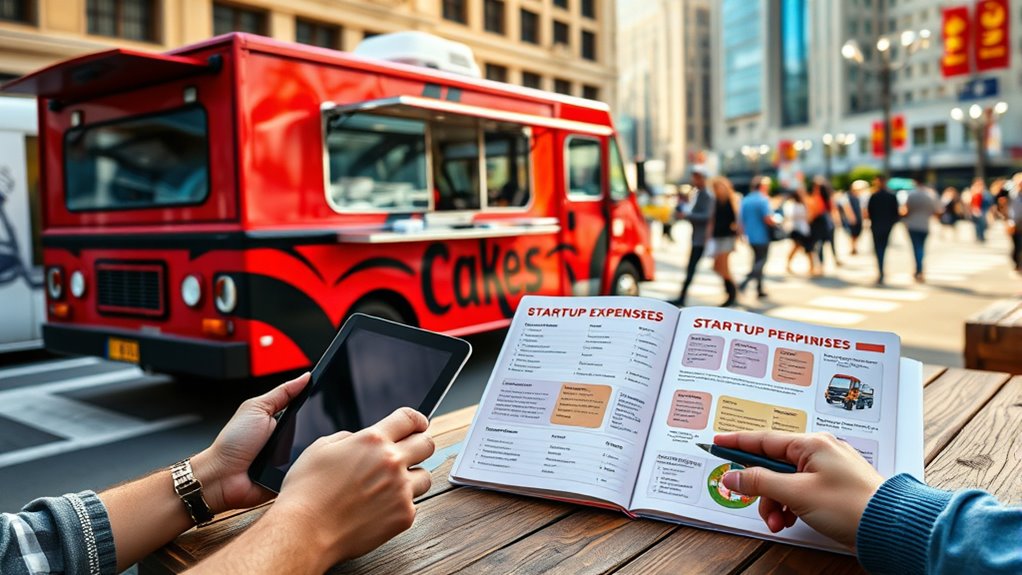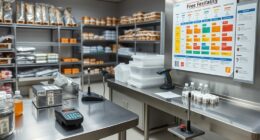To calculate your food truck startup costs, start by considering your vehicle expenses, whether buying or leasing, and include customization and equipment like ovens or grills. Add licensing, permits, and insurance fees, which vary by location. Include initial inventory, supplies, marketing, and branding costs. Don’t forget ongoing expenses like wages and maintenance. With careful planning, you’ll have a clear budget—continue exploring to uncover detailed steps to keep your costs on track.
Key Takeaways
- Identify all vehicle costs, including purchase or leasing, customization, and branding expenses.
- Calculate licensing, permits, insurance, and regulatory fees based on location-specific requirements.
- Estimate initial inventory, supplies, and equipment costs for kitchen setup and daily operations.
- Include marketing, branding, and location-related expenses to attract customers and establish presence.
- Account for ongoing costs such as wages, utilities, maintenance, and variable operational expenses.
Estimating Vehicle and Equipment Expenses

Estimating vehicle and equipment expenses is a crucial step in calculating your food truck startup costs. You’ll need to decide between buying, leasing, or retrofitting a truck or trailer. New trucks range from $50,000 to $175,000, while used options cost between $30,000 and $100,000, often requiring renovations. Leasing can cost around $2,000 to $3,000 monthly, ideal for testing markets. Trailers vary from $15,000 to $100,000, depending on size and features. Kitchen equipment also adds up; a quality griddle costs $2,000–$6,000, fryers $1,500–$4,000, and ventilation systems $5,000–$10,000. Vehicle customization, branding, and signage can range from $2,500 to $15,000. Carefully estimating these costs helps you build a realistic budget for launching your food truck. Researching financing options can also help manage upfront expenses effectively.
Navigating Licensing, Permits, and Insurance Costs
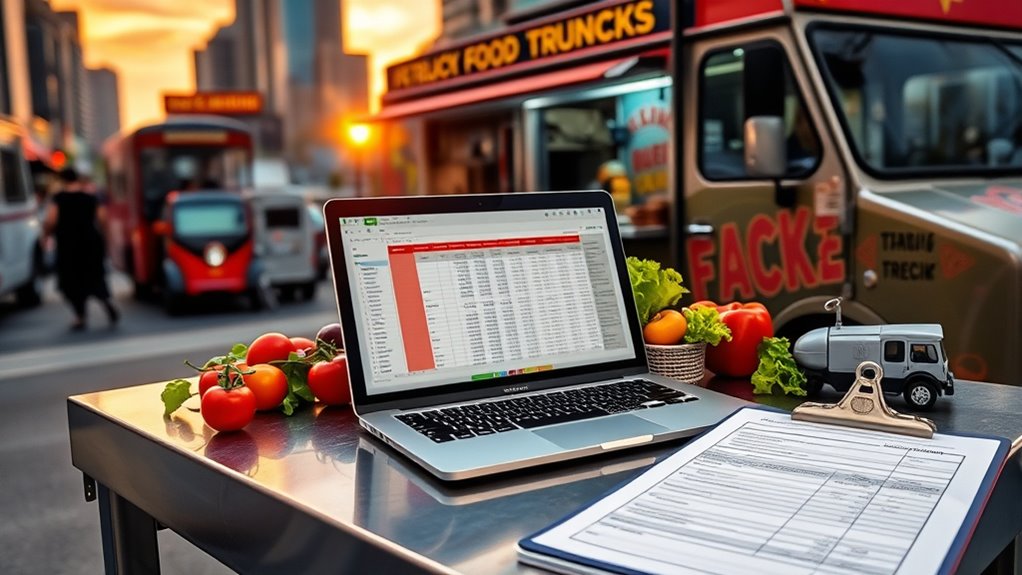
Understanding the licensing, permit, and insurance requirements is a vital step in preparing your food truck for operation. You’ll need a food service license, which typically costs $100 to $1,000, depending on your location and menu. A mobile food vendor permit, often ranging from $100 to over $1,000, legalizes your vending activities. The health department permit, usually $100 to $500, guarantees compliance with safety standards. If you use flammable materials like propane, a fire department permit costing $50 to $200 is necessary. Additionally, a business license, often a one-time fee between $50 and $500, registers your business. Expect overall licensing costs to vary widely by city—averaging around $1,864 in many areas—and budget for mandatory insurance, which can range from $1,500 to $4,000 annually. Permit costs are heavily influenced by local regulations and city size, so it’s important to research specific requirements in your area to ensure full compliance. Being aware of regulatory variations can help you better plan your startup budget and avoid unexpected expenses.
Calculating Initial Inventory and Supplies
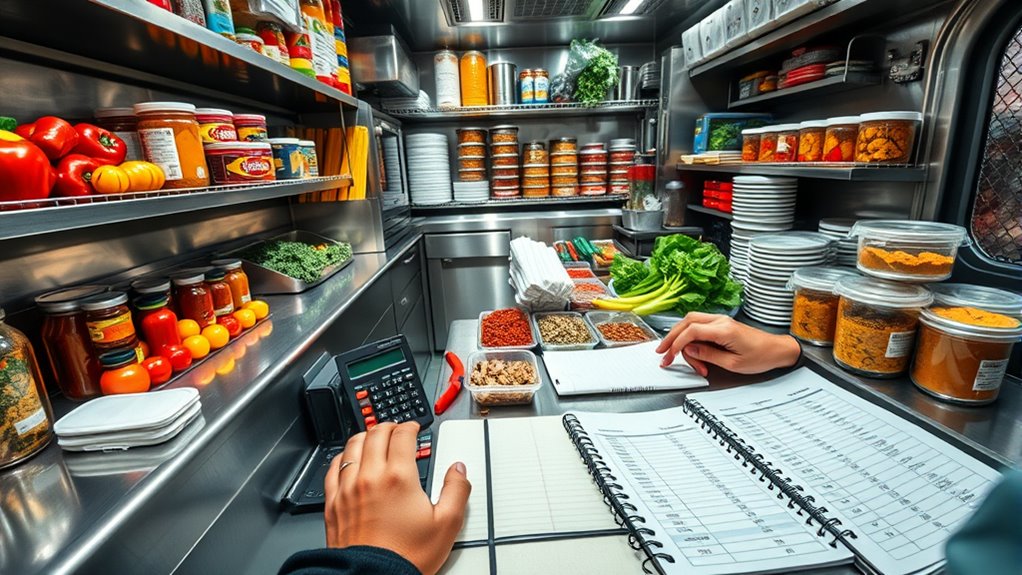
Determining your initial inventory and supplies is an essential step in launching your food truck, as it directly impacts your ability to serve customers smoothly from day one. You’ll need to estimate food costs, which can range from $2,000 to $8,000 depending on your menu complexity and expected sales volume. Market research helps forecast the right quantities, especially for perishables, to minimize waste without sacrificing menu availability. Budget around $200 to $500 for essential packaging materials like boxes, wrappers, and napkins, while basic serveware costs about $300. Don’t forget to stock necessary supplies such as cooking oils, spices, cleaning agents, and food safety materials. Proper organization and storage solutions are crucial for maintaining freshness and minimizing spoilage, ensuring your inventory supports efficient daily operations. Accurate inventory management is vital for controlling costs and avoiding shortages during busy service periods, and investing in proper storage solutions can significantly reduce product loss.
Understanding Operating Expenses and Overhead

Managing operating expenses and overhead is crucial for keeping your food truck running smoothly and profitably. Fuel costs can range from $300 to $1,000 monthly, depending on routes and generator use, while utilities like propane and electricity typically cost $200 to $500. You’ll also need to budget for generator purchases, which can be $500 to $3,000, plus ongoing maintenance of $500 to $1,000 monthly. Labor costs are a major expense, usually between $6,000 and $12,000 monthly for 2-4 staff members, influenced by wages and hours worked. Parking and space rental fees vary from $250 to over $1,000, depending on location. Permits, licensing, and insurance can add several hundred dollars monthly, and routine maintenance costs around $500 to $1,000, ensuring your truck stays in top shape. Additionally, understanding Eye Patch Benefits can help improve the appearance of your vehicle’s branding or promotional materials, making your food truck more attractive to potential customers.
Budgeting for Marketing and Branding Efforts

Budgeting for marketing and branding efforts is essential to guarantee your food truck attracts customers without overspending. Typically, you should allocate 5% to 10% of your total sales for marketing, with new trucks aiming closer to 10% to build brand awareness. As your business stabilizes and revenue grows, adjust your marketing spend to balance growth goals with your financial capacity. Focus on low-cost or free methods like social media, which 68% of food truck owners use regularly, especially Facebook. Participating in events boosts visibility and customer engagement, while loyalty programs can increase repeat visits by 30%. Initial branding costs, such as logo design and truck wraps, vary but should be considered upfront to establish a cohesive identity. Tracking your ROI helps refine your marketing strategy and maximize impact. Using data-driven insights, you can better allocate your marketing budget to the most effective channels and campaigns. Additionally, incorporating AI security into your digital marketing efforts can help protect your customer data and enhance trust.
Factoring in Location and Commissary Fees
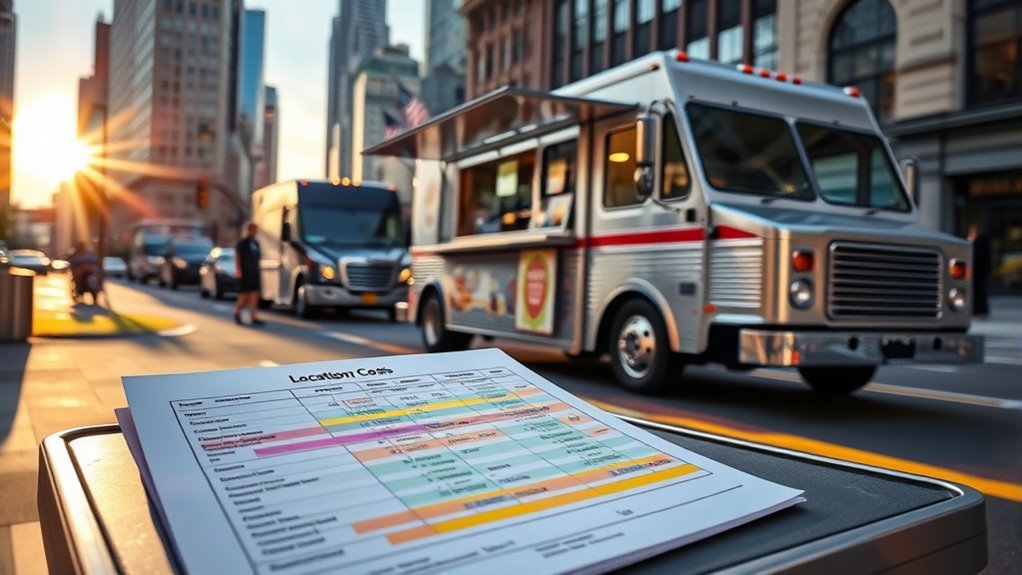
Location and commissary fees are key factors that directly influence your start-up costs and ongoing expenses. Your choice of location impacts rent, permits, and potential sales volume, with fees ranging from $500 to over $3,000 monthly depending on foot traffic and city regulations. High-traffic areas command higher fees but can boost sales. Commissary costs, usually between $500 and $2,000 monthly, cover certified kitchen space and utilities, with shared facilities offering savings. Permitting and licensing costs vary widely, sometimes exceeding $1,000 annually, and depend on local laws and zoning restrictions. Effective management includes negotiating long-term leases, selecting facilities with bundled services, and choosing off-peak spots to balance visibility and costs. Additionally, understanding the cost and budgeting considerations for your food truck can help you plan more accurately for your overall start-up budget and operational feasibility.
Analyzing Cost Variations by Market and Scale

The costs of starting a food truck vary considerably depending on the regional market and the scale of your operation. In larger cities like New York or Los Angeles, permit fees, rent, and equipment costs are higher, pushing startup budgets toward $150,000 to $300,000. Smaller markets or rural areas offer lower costs—up to 50% less—thanks to cheaper permits and less regulatory complexity. Your chosen scale also impacts expenses: a small startup with a used truck might spend $50,000 to $80,000, while a medium operation with a new custom truck could need $75,000 to $150,000. Larger fleets or multi-truck setups exceed $200,000, with costs rising for equipment, technology, and insurance. Regional regulations can significantly influence overall costs and operational requirements, further affecting your startup planning and budget. Additionally, understanding the cost variations across different markets helps in creating a more accurate and effective financial plan.
Developing a Comprehensive Startup Cost Breakdown
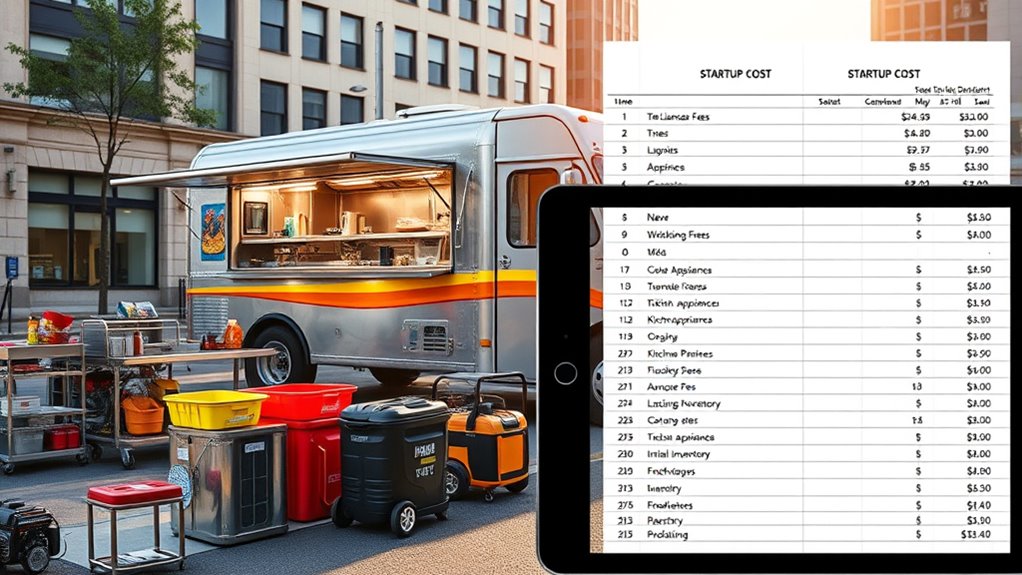
Creating a thorough startup cost breakdown for your food truck involves identifying all essential expenses from purchase to ongoing operations. You need to account for vehicle costs, customization, licenses, permits, inventory, insurance, equipment, and utilities. Start by estimating whether you’ll buy new, used, or lease, then add customization and kitchen setup costs. Don’t forget licensing and permit fees, which vary by location, and include initial inventory and supplies to ensure smooth daily operations. Additionally, budget for insurance, marketing, and miscellaneous expenses like staff wages and vehicle maintenance. To streamline your planning, consider these key components: juice detox – understanding health trends can help tailor your menu offerings to attract health-conscious customers.
Frequently Asked Questions
How Long Does It Typically Take to Recoup Initial Startup Costs?
You’re curious about how long it takes to recoup your initial investment. Typically, you can expect to break even within 6 to 12 months, but it might stretch to 18 months or even two years depending on your costs, location, and sales. High-traffic urban spots, efficient operations, and tech adoption can speed up this process. Keep a close eye on expenses and revenue to stay on track.
What Unexpected Expenses Should New Food Truck Owners Prepare For?
You should brace for unexpected expenses like hefty permits and licenses, which can cost over $28,000 annually. Ongoing regulatory compliance, vehicle repairs, fuel, parking fees, and insurance also add up quickly. Plus, factor in surprise marketing costs, such as branding updates or event fees, and fluctuating staffing and supply chain expenses. Planning for these surprises guarantees you’re financially prepared to keep your food truck running smoothly.
How Do Seasonal Fluctuations Impact Overall Startup Costs?
Seasonal fluctuations greatly impact your startup costs by influencing inventory, equipment, and staffing needs. You might spend more on winter heating or summer cooling, and adjust your menu seasonally, which affects ingredient sourcing. Preparing for these variations means investing in flexible supply chains and adaptable marketing. While initial costs may be higher due to these seasonal adjustments, planning well ensures you can handle off-peak slowdowns and capitalize on peak seasons.
Are There Financing Options Specifically for Food Truck Startups?
You’ll find financing options tailored for food truck startups, like SBA microloans, equipment financing, and business lines of credit, which help cover essential costs. These options often have flexible terms, even for those with challenged credit. Crowdfunding and community programs also support your venture. By preparing a solid business plan and understanding your funding needs, you can secure the right financing to get your food truck on the road.
How Do Local Regulations Influence Total Startup Investment?
Local regulations greatly influence your total startup investment by adding permit, licensing, and compliance costs that vary by city. You’ll face different fees, inspection requirements, and renewal expenses depending on where you operate. Complex regulations mean higher initial costs and ongoing expenses, while simpler systems keep costs lower. These rules can also impact your business timeline and profitability, so you need to factor them into your overall budget carefully.
Conclusion
As you chart your food truck’s journey, remember each cost is a stepping stone, guiding you toward your dream. Every dollar invested is like planting a seed—nurturing your future success. Stay mindful of the balance between upfront expenses and ongoing costs, like the steady rhythm of a heartbeat. With careful planning and clarity, you’ll navigate this landscape smoothly, turning your vision into a vibrant, mobile kitchen that feeds both bodies and ambitions.
